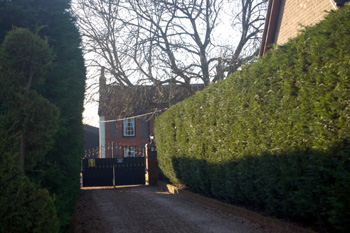
Old Farm seen from Station Road December 2008
In 1912 both Church Farm and Old Farm, with other land in Stanbridge, were sold by the trustees of the late Mrs.Littleboy, widow of Richard Littleboy [P57/28/3]. Old Farm formed Lot 3. It had 100 acres 3 roods of land as shown on the plan below (click on the image to see a larger image of the same). The tenant, A.D.Hawkins, paid £80 per annum rent.

Old Farm in 1912
The fields were as follows:
- 51: Twenty Acre Field - 20 acres 1 rood 4 perches of arable;
- 51a: Twenty Acre Field - 24 acres 1 rood 4 perches of pasture;
- 55: Corner Field - 3 acres 3 roods 12 perches of pasture;
- 56: The Lake - 17 acres 2 roods 36 perches of arable;
- 57: Big Meadow - 25 acres 2 2perches of pasture;
- 135: Clarks Close - 3 acres 31 perches of pasture;
- 136: Rickyard - 1 rood 37 perches;
- 137: Home Close - 3 acres 2 roods 36 perches of pasture;
- 144: Home Close - 36 perches of pasture;
- 145: House and buildings - 1 acre 3 roods 22 perches.
The farm is described as: "an excellent Brick and Tiled Dwelling House, containing Cellar, Front Entrance Hall, Two Living Rooms, Kitchen, Scullery, Dairy and Pantry on ground Floor and Three Bedrooms and Dressing room above. The Compact Outbuildings comprise, a 3-bay Cart Shed, Coach-house, Stable for 5 horses with loft over, Chaff house, Harness Store, 3 Loose Boxes, Threshing Barn, Mixing House, Piggeries, 3 Hovels, Poultry House, Cowhouse to stall 9 cows and 6 Piggeries. In the adjoining Yard there are 3 Loose Boxes, Threshing Barn, Poultry House, Stable, a 4-bay Hovel, a corrugated iron Hay Barn, 63 feet by 18 feet, and Two Brick and thatched Cottages wit h3 Living rooms and Scullery and 2 Bedrooms above". The particulars are annotated with the note that the farm was bought by Frederick Chandler of Linslade, for £1,800 and resold by him to Samuel Bunker.
It is not widely remembered today but in 1917 Britain was facing starvation. The unrestricted German U-Boat campaign was destroying large numbers of ships carrying food across the Atlantic. As something of a panic measure it was decided to plough up old grassland in an effort to plant more arable crops to feed the country. County War Agricultural Executive Committees were given the task of finding suitable land. Usually the farmer objected, for the good reason that he knew that any crop obtained would be poor and/or uneconomic. John Griffin at Bury Farm was ordered to plough up some of his grassland [WW1/AC/OP1/1-2] and duly objected for just these reasons. Eventually, the convoy system was introduced and matters eased enough to obviate the need to plough up meadow and pasture.
In 1917 John Griffin was tenant of Old Farm. He bought it at auction in May 1921 and had no sooner taken out a mortgage than he was stung in the neck be a bee and died of shock the next day, leaving his widow to manage as best she could. She sold some of the land to William Saunders in 1921 for £1,210 [Z1390/2/JG5] and the farm buildings and the rest of the land to Frank Septimus Abraham in 1925 for £1,930 [Z1390/2/JG10].
The Rating and Valuation Act 1925 ordered every piece of land and building in the country to be assessed to determine the rates to be paid on it. Stanbridge was assessed in 1927 and the valuer visiting Old Farm [DV1/H28/24] noted that the owner/occupier was still Frank Septimus Abraham and the farm contained 52 acres; the valuer noted: "Bad soil. Was a larger farm, part of homestead let off" and "Nice house, good homestead".
The house, built of brick, tile and corrugated iron contained two reception rooms, a kitchen, washhouse, dairy and cellar with four bedrooms above and a pump house and a brick, wood and slate three bay open cart shed and trap house outside. The homestead comprised:
- West Yard: a brick and tile stable for six and harness room all with loft over; a weather boarded and corrugated iron barn; a wood place; a henhouse; two loose boxes; a brick, wood and tile three bay open cart shed; a wood, brick and corrugated iron eight bay open feeding hovel; three brick and tile piggeries and a weather boarded and corrugated iron cow house for ten;
- Centre Block: a wood, brick and corrugated iron granary;
- East Yard ("sub-let"): a wood, brick and corrugated iron wood shed and store place; a stone and thatch feeding hovel ("nearly derelict"); a brick, wood and corrugated iron barn with a feeding hovel in; a weather boarded and corrugated iron four bay open hovel and a weather boarded and corrugated iron feeding hovel with a loft over used as a store;
- In the fields: a corrugated iron roofed Dutch barn
In 1933 Frank Septimus Abraham sold Old Farm to Charles Wood who, in the next year conveyed it to George Wood [CCE5346/1]. In 1963 George Wood sold the farm, then measured as 51.685 acres, to Edwin Thomas French of Park Farm, Eaton Bray [CCE5346/1]. The farm was sold again, in 1986, to Barbara Jean Lawrence [CCE5346/1] and sold again in 1993. The following year part of the farm was conveyed to Bedfordshire County Council who used the land for part of the Leighton-Linslade Bypass [CCE5346/5].